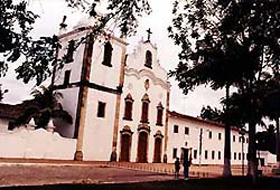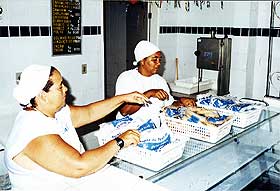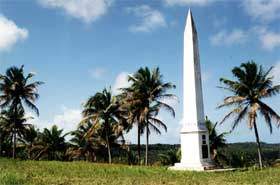Facts
Culture
Travel
Beaches
Porto de Galinhas
Hotels
Restaurants
World Cup
Olinda
Pernambuco
|
Goiana - Pernambuco
«Recife
«Cities of Pernambuco
Population: 71.177 inhabitants (Census 2000)
Distance from Recife: 60 km
Accesses: BR-101,PE-15 e PE-01 (Paulista route). Leaving Recife, just take the BR-101 Norte (North) and keep going; Goiana is about 10 km before the border between Pernambuco and Paraíba. Visit maps of Recife and Pernambuco for more info.
History
The first inhabitants of the area where today lies the city of Goiana were the tribes of Caetés and Potiguares. Being one of the first areas to be occupied by the Portuguese settlers, there are registers of dwellers from as early as 1570; the official year of foundation of Goiana is 1568.
Libertarian, Goiana was the first city in Pernambuco to free their slaves (in an epoch when sugar mills depended heavily on slave work force).
Goiana staged also another important historic event, the Epopéia das Heroínas de Tejucupapo (Epic of the Heroines of Tejucupapo).
 The episode took place in 1645, when the Dutch invaders were under attack by the Brazilian and Portuguese forces, led by André Vidal de Negreiros; the Dutch fled to Forte Orange, in Itamaracá. Besieged by the enemy troops, soon the Dutch were running out of food and suffering with escorbuto, illness caused by the lack of vitamine C in the organism.
The episode took place in 1645, when the Dutch invaders were under attack by the Brazilian and Portuguese forces, led by André Vidal de Negreiros; the Dutch fled to Forte Orange, in Itamaracá. Besieged by the enemy troops, soon the Dutch were running out of food and suffering with escorbuto, illness caused by the lack of vitamine C in the organism.
The Dutch tried to overtake the Tejucupapo village, in Goiana, where there were plantations of cashew, a fruit very rich in vitamine C. Commanded by Admiral Lichthant, about 600 Dutch left Itamaracá, sailing, towards Tejucupapo. To defend the city, the no more than one hundred men carved a trench; during the battle, 23 Dutch were killed, starting a rage among the invaders.
Noticing the Dutch superiority, Maria Camarão, with a crucifix in hand, cried around the village, summoning the women to take in arms and help the men on the battle against the enemy troops. On April 24th of 1646, armed with sticks, stones, pans, pepper and hot water, the women of Tejucupapo won the battle against the Dutch. The Igreja de São Lourenço de Tejucupapo (Church of São Lourenço of Tejucupapo), dedicated to the dead in the war, is today part of the Heritage of the State of Pernambuco.
The episode entered Brazilian History as one of the few battles seeing women in battle fields. A movie was shot to portray the event; visit the site about the movie Epopéia das Mulheres de Tejucupapo.
The city of Goiana comprehends the head district, the districts of Pontas de Pedra and Tejucupapo, and the villages of Frecheiras, Melões, Gambá, Ibeapicu, Barra de Catuama, Atapuz, Carne de Vaca, São Lourenço and Carrapicho.
Goiana celebrates its political autonomy on May 5th. The Saint of the city is São Sebastião.
Economy
Goiana had, since the 16th century, the economy based exclusively on the sugar cane monoculture; currently, there are efforts to diversify the economy. Activities like food processing (photo) are gaining strenght. The cane industry, however (from the plantation of the cane to the production of sugar and alcohol in mills), is still the most important economic activity of Goiana, being by far the largest employer sector. 
Goiana is locate in the Mata Norte Development Region, in the mesoregion of the Mata Pernambucana (see map of Pernambuco). This Region covers about 3,29% of the State territory, with 3.256,5 km²; the following cities are also part of the Region: Aliança, Buenos Aires, Camutanga, Carpina, Chã de Alegria, Condado, Ferreiros, Glória do Goitá, Itambé, Itaquitinga, Lagoa do Itaenga, Lagoa do Carro, Macaparana, Nazaré da Mata, Paudalho, Timbaúba, Tracunhaém and Vicência.
With the Economy based on agriculture, this region has as main activity the sugar cane industry.
The History of Goiana is closely related to the mills of the region. During the colonial periods, Goiana was one of the most important producer of sugar in Pernambuco; the Goiana river, which crosses the city, had a large port, used to export the local production. For more Historic info, visit this page which tells more about some of the sugar mills in Pernambuco.
Tourism
The Tejucupapo's Heroins Epic, occured on the XVII century (see above), in which women expelled the Dutch, is one of the landmarks of Goiana. To remember the event, every year about 200 women of the region congregate near the Tejucupapo obelisk (picture), to play History of their heroins.
 This exhibition on the last Sunday of April, and serves as a class of History and determinism. The play was adapted to represent the lives of Women which fight against invaders and sexism.
This exhibition on the last Sunday of April, and serves as a class of History and determinism. The play was adapted to represent the lives of Women which fight against invaders and sexism.
Goiana also hosts many religious monuments. There are ten Historic churches in the city; the most important ones are those of Nossa Senhora do Rosário dos Homens Pretos (Our Lady of Rosary of Black Men), the Nossa Senhora do Amparo dos Homens Pardos (Our Lady of Help of Brown Men) and the Matriz de Nossa Senhora dos Homens Brancos (Our Lady of White Men); these churches appear in the list of the oldest in Brazil. The Conjunto Carmelita attracts pilgrims who come
to visit the Igreja de Nossa Senhora do Carmo and the Cruzeiro carved in limestone.
Located near the coast of Pernambuco, Goiana has beautiful beaches, such as Pontas de Pedra, Catuama, Carne de Vaca, Tabatinga and Atapuz; many families keep beach houses here, and the area gets busy in holidays. The northern part of Pernambuco coast is not so popular yet as the southern part; however, realtors and tourism enterprises are already investing in properties here.
Goiana is also known for their handicraft, particularly the production of pottery pieces, which are benefited from the abundance of clay in the region; the works usually personify bandits, Saints and other characters which inhabit the folklore of people in the Northeast. Deserves a mention the pottery artisan João Boneco, the master Joaozinho, who helped spread the fame of the figurative pottery of Goiana; Antônia Leão, Teófilo Neves and José do Carmo are other artists of prestige.
During carnival, the city is taken by popular culture, with representations of maracatus and, most important, caboclinhos (Goiana claims the title of Land of Caboclinhos). On the Tuesday of carnival, over 30 groups of Caboclinhos congregate to pay a tribute to the indian culture, which had strong influence on the culture of the region.
|
|